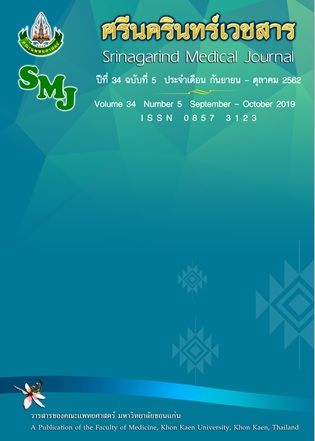The Cut-off Scores of the Three-time Stand and Walk Test to Predict the Risk of Falls in Community-Dwelling Elderly Thais
Keywords:
Falls, Elderly, Functional ability, Physical Therapy, Three-time stand and walk test, การล้ม, ผู้สูงอายุ, ความสามารถทางกาย, กายภาพบำบัด, การทดสอบลุกยืน 3 ครั้งแล้วเดินAbstract
ค่าตัดแบ่งของการทดสอบลุกยืน 3 ครั้งแล้วเดิน ในการทำนายความเสี่ยงต่อการล้มในผู้สูงอายุไทยในชุมชน
อรุณรัตน์ ศรีทะวงษ์1, วินัฐ ดวงแสนจันทร์2, พุทธิพงษ์ พลคำฮัก1*
1สาขาวิชากายภาพบำบัด คณะสหเวชศาสตร์ มหาวิทยาลัยพะเยา ประเทศไทย 56000
2 สาขาวิชาการพยาบาลผู้ใหญ่และผู้สูงอายุ คณะพยาบาลศาสตร์ มหาวิทยาลัยวงษ์ชวลิตกุล จังหวัดนครราชสีมา 30000
หลักการและวัตถุประสงค์: การศึกษานี้มีวัตถุประสงค์เพื่อ ศึกษาค่าตัดแบ่งที่เหมาะสมของการทดสอบลุกยืน 3 ครั้งแล้วเดิน (the three-time stand and walk test; TTSW) ในคนไทยสูงอายุ
วิธีการศึกษา: อาสาสมัครถูกแบ่งเป็นช่วงอายุ 3 ช่วงตามการเปลี่ยนแปลงทางด้านสรีรวิทยา ได้แก่ 60-69 ปี 70-79 ปี และ 80 ปีขึ้นไป โดยอาสาสมัครทั้งหมด จำนวน 186 ราย (กลุ่มละ 62 ราย) จะได้รับการสัมภาษณ์ ซักประวัติข้อมูลพื้นฐาน ภาวะทางสุขภาพและประวัติการล้มย้อนหลัง 6 เดือน อาสาสมัครถูกแบ่งกลุ่มเป็นกลุ่มที่เคยล้มและไม่เคยล้ม หลังจากนั้นอาสาสมัครได้รับการทดสอบลุกยืน 3 ครั้งแล้วเดิน โดยทำการทดสอบทั้งหมด 3 รอบ และหาค่าเฉลี่ย เพื่อนำไปใช้วิเคราะห์ทางสถิติ
ผลการศึกษา: อาสาสมัครส่วนใหญ่ เป็นเพศหญิง และมีค่าเฉลี่ยของดัชนีมวลกายอยู่ในช่วงปกติและไม่มีความแตกต่างกันระหว่างกลุ่มที่เคยล้มและไม่เคยล้มในทุกช่วงอายุ อาสาสมัครในกลุ่มที่มีประวัติการล้มมีค่าเฉลี่ยเวลาที่ใช้ในการทดสอบ TTSW มากกว่ากลุ่มที่ไม่เคยล้มอย่างมีนัยสำคัญทางสถิติ (p≤0.001) ผลการศึกษาค่าตัดแบ่งพบว่า มีค่าตัดแบ่งในแต่ละกลุ่มอายุ เท่ากับ 14.00 วินาที 14.13 วินาที และ 15.30 วินาที ตามลำดับ โดยมีค่าความไว ความจำเพาะ ค่าความถูกต้องในการทำนาย และพื้นที่ใต้กราฟของการทดสอบ TTSW ในแต่ละช่วงอายุอยู่ในระดับสูง
สรุป: ค่าตัดแบ่งของการทดสอบ TTSW ในแต่ละช่วงอายุสามารถใช้เป็นเกณฑ์ในการประเมินความเสี่ยงต่อการล้มในผู้สูงอายุในชุมชนได้
Background and objective: This study aimed to explore optimal cut-off scores of the three-time stand and walk test (TTSW) in elderly Thais.
Methods: Based on the physiological changes, participants were divided into 3 age groups; 60-69 years, 70-79 years, and 80 years or more. The total of 186 participants (62 participants per age group) were interviewed and subjective examined for their demographics, health status and their history of falls within the past 6 months. All participants were divided into 2 groups: falls and non-falls. Thereafter, participants were performed the TTSW for 3 trials, and the mean values obtained from 3 trials were used for statistical analyses.
Results: Most of study participants were female. There was no significant difference in body mass index between falls and non-falls. Participants in the fall group had a significantly higher mean TTSW scores than those in the non-fall group (p<0.001). The mean cut-off scores of TTSW in each age group were 14.00, 14.13, and 15.30 seconds, respectively, with high sensitivity, specificity, predictive accuracy and area under receiver operating characteristic (ROC) curve of the TTSW test in each group.
Conclusions: This study concluded that the cut-off scores of the TTSW in each age group could be used as a criterion value for assessing the risk of falling in community-dwelling elderly participants.
References
Poncumhak P, Sittitan M, Thammachai A, Wongsaya E. The Development of the Three Times Stand and Walk Test for Predict Risk of Falls in Thai Community-Dwelling Elderly. Thai J of Phy ther 2016; 38: 48-58.
Poncumhak P, Sittitan M, Srithawong A. Inter Tester Reliability and Validity of the Three Times Stand and Walk Test (TTSW) in Healthy Adolescent. Thai J of Phy ther 2015; 37: 91-9.
Podsiadlo D and Richardson S. The timed "Up & Go": a test of basic functional mobility for frail elderly persons. J Am Geriatr Soc 1991; 39: 142-8.
Shumway-Cook A, Brauer S, Woollacott M. Predicting the probability for falls in community-dwelling older adults using the Timed Up & Go Test. Physical therapy 2000; 80: 896-903.
Whitney SL, Wrisley DM, Marchetti GF, Gee MA, Redfern MS, Furman JM. Clinical measurement of sit-to-stand performance in people with balance disorders: validity of data for the Five-Times-Sit-to-Stand Test. Phys Ther 2005; 85: 1034-45.
Csuka M, McCarty DJ. Simple method for measurement of lower extremity muscle strength. Am J Med 1985; 78: 77-81.
Poncumhak P, Maitip S, Srithawong A. The Development of Simple Screening Tool for Predict Risk of Falls in Thai Community-Dwelling Elderly. J Med Assoc Thai 2016; 99: 7.
Wongsaya E, Poncumhak P, Thammachai A, Jermchalerm G, Kanta T, Chankeaw N. Validity of a Three Times Stand and Walk Test (TTSW) for the Measurement of Physical Function in Elderly. Srinagarind Med J 2016; 31: 197-201.
Arnau A, Espaulella J, Serrarols M, Canudas J, Formiga F, Ferrer M. Risk factors for functional decline in a population aged 75 years and older without total dependence: A one-year follow-up. Arch Gerontol Geriatr. 2016; 65: 239-47.
Thaweewannakij. T, Amatachaya. S, Peungsuwan. P, Mato L. Balance, fall and quality of life in active and inactive elderly. J Med Tech Phy Ther 2010; 22: 271-9.
Chirawatkul. A. Statistics for health science research. bangkok: Wittayaphat; 2009.
Akobeng AK. Understanding diagnostic tests 3: Receiver operating characteristic curves. Acta Paediatrica 2007; 96: 644-7.
Fan J, Upadhye S, Worster A. Understanding receiver operating characteristic (ROC) curves. Cjem. 2006; 8(1): 19-20.
Rubenstein LZ, Josephson KR. The epidemiology of falls and syncope. Clin Geriatr Med 2002; 18: 141-58.
Rubenstein LZ. Falls in older people: epidemiology, risk factors and strategies for prevention. Age Ageing 2006; 35 (Suppl 2): ii37-ii41.
Poncumhak P, insorn T, Prasittimet N, Manota P. The Pilot Study on the Risk of Fall Prediction in Thai Elderly Using Five Times Sit-to- Stand Test. Srinagarind Med J 2014; 29: 237-42.
Thiamwong L, Suwanno J. Risk Factors Related To Balance Impairment Among Rural Community-Dwelling Older Adults. JOPN 2014; 6: 56-68.
Ambrose AF, Paul G, Hausdorff JM. Risk factors for falls among older adults: a review of the literature. Maturitas 2013; 75: 51-61.
Lord SR, Murray SM, Chapman K, Munro B, Tiedemann A. Sit-to-stand performance depends on sensation, speed, balance, and psychological status in addition to strength in older people. J Gerontol A Biol Sci Med Sci 2002; 57: M539-43.


